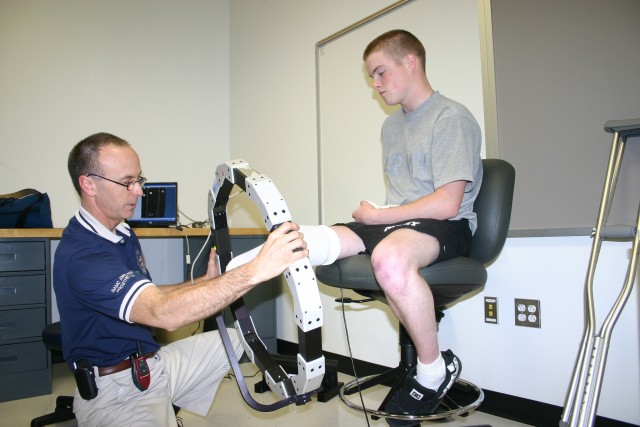FORT SAM HOUSTON, Texas (Army News Service, March 15, 2007) - With a one-of-a-kind virtual reality simulator and a sports program that could challenge even the most intense extreme sports fan, the Army's new physical rehabilitation center offers patients "therapy disguised as fun," said Col. John Shero, deputy chief of administration, Brooke Army Medical Center, at a March 8 facility tour.
The four-story, 65,000-square-foot Center for the Intrepid includes clinical, research and administrative space; a gait lab; a Computer Assisted Rehabilitation Environment, or CAREN; indoor running track; two-story climbing wall; and a prosthetic fabrication laboratory.
"The equipment and technology are without parallel anywhere in the world," said Col. Mark Bagg, director, CFI, and chief of orthopedics, BAMC.
All of it is designed to help wounded warriors with severe extremity injuries, burns and amputations maximize their ability to live and work productively. The custom equipment is also designed to ensure the wounded warriors have some fun along their road to recovery.
The Military Performance Lab, for instance, includes the CAREN, a 21-foot dome with a 300-degree screen that displays a variety of virtual realities. Patients stand on a moving platform that can sway like a speed boat on a choppy ocean or incline when taking a simulated hike through the woods. City street simulations also help patients transition to the hustle of everyday life as they dodge fast walkers on crowded city streets. The state-of-the-art simulator is one of nine in the world and the only one in the United States.
The Firearms Training Simulator puts wounded warriors through a series of dangers, testing their ability to swiftly react and fire on threats. FATS not only trains their hand-eye coordination, but also keeps patients current with weapons systems common to the military.
"It feels great," said Marine Staff Sgt. Alejandro Del Rio, who was trying out the simulator for the first time. Del Rio was severely wounded in Iraq by a bomb blast. He lost both of his legs below the knee, sustained damage to his right arm and part of his left hand and forearm.
Despite the injuries, Del Rio fired with ease.
On the sports front, patients can work their way to the top of a 21-foot climbing tower or play volleyball in the six-lane pool. "The Flowrider," which enables wounded warriors to "ride" the waves on a bodyboard, is used to improve balance, coordination and strength.
"It's physically exerting, but you get this rush," said Staff Sgt. William Corp, a below-the-knee amputee, who excelled at The Flowrider on his first try.
Much of CFI's equipment is geared, not just toward rehabilitation, but research. The gait lab analyzes human motion, with an emphasis on walking. The information collected at the lab, as well as from the CAREN, can ultimately help physicians, physical therapists and prosthetists adjust their treatment plans and improve patient function.
"We're learning at the same time the patients are getting therapy," Bagg said.
The Center for the Intrepid was a gift to the Army from Americans. More than 600,000 people donated $50 million to the Intrepid Fallen Heroes Fund to build the center, which opened with much fanfare in late January.
The facility, Bagg said, is a "dream come true."
(Elaine Wilson writes for the Fort Sam Houston Public Information Office.)


Social Sharing